From ancient tribes to contemporary cities, body piercing is a phenomenon that bridges time and space. Its universal allure ties diverse cultures together. Meanwhile, its varied significance gives each society its unique spin on the practice.
Traditions and Tribes: Origins of Piercing
The allure of body piercing dates back millennia. Tribes from the vast African plains, the lush landscapes of the Americas, and the enigmatic Pacific Islands have, for generations, decorated their bodies with piercings. These practices could symbolize rites of passage, acts of bravery, or simple aesthetic choices. The diversity in the reasoning behind each piercing paints a vivid picture of the world’s cultural richness.
For example, Bali intertwines piercing with spirituality. Here, elaborate ear and nose piercings are not just accessories. They are deeply rooted in traditions, often used to establish a connection with the divine during sacred ceremonies. Many piercing shops in Canggu, a suburb on the South coast of Bali, offer a unique piercing experience.
Thailand also offers a captivating blend of the old and new in piercing traditions. The Kayan women, known for their elongated earlobes, represent age-old customs. Meanwhile, the intense body piercings witnessed during the Vegetarian Festival in Phuket are a testament to both devotion and aesthetics.
In the vibrant tapestry of Indian cultures, body piercing also stands out prominently. Nose piercings, especially, are rich with symbolism. Often indicative of marital status, they’re also tied to Ayurvedic beliefs, which advocate specific piercings for health benefits.

Piercing as a Status Symbol
Across varied cultures, piercings serve as more than just body modifications. In many societies, they are clear indicators of one’s social standing or even profession. The use of gold or precious gem-studded jewelry might hint at affluence, whereas specific piercings could be reserved for tribal leaders or spiritual heads.
Modern Adaptations: A Fusion of Old and New
Today’s piercing landscape is a melting pot of ancient practices and modern interpretations. Studios worldwide offer everything from intricate tribal patterns to sleek, minimalist designs. This evolution, however, never loses touch with the rich history from which it sprang.
Selecting the Right Piercing Shop
Deciding on the piercing is half the journey; the other half is choosing the right shop to bring that vision to life.
- Reputation and Reviews: Before taking the plunge, delve into online reviews. These insights from past customers can be invaluable, shedding light on the shop’s professionalism and hygiene standards.
- Sanitation: The importance of hygiene can’t be overstated. The shop should prioritize cleanliness. Sterilized instruments and pristine workspaces are non-negotiable.
- Experienced Professionals: The skills of the piercer can make or break the experience. Seasoned professionals provide a steady hand and offer invaluable guidance on placement and design.
- Licensing: Ensure that the establishment is licensed. This ensures that they comply with vital health and safety regulations, safeguarding you throughout the procedure.
- Portfolio: Familiarize yourself with the piercer’s previous work. Their portfolio clearly shows their expertise, style, and versatility.
- Aftercare Guidance: A piercing is a commitment. The best shops equip you with comprehensive aftercare instructions, guiding you through the healing process and helping you avoid complications.
Universal Yet Unique
Piercing is an art form as old as civilization itself. Its universal appeal draws people from all walks of life, yet its individual significance ensures that it remains a unique form of self-expression. From the tribes of yore to the bustling streets of today’s metropolises, each piercing tells a story. It’s a tale of heritage, individuality, and the shared human experience that binds us all.